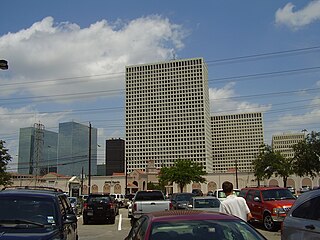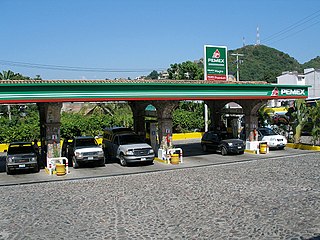Related Research Articles

Pemex is the Mexican state-owned petroleum company managed and operated by the Mexican government. It was formed in 1938 by nationalization and expropriation of all private oil companies in Mexico at the time of its formation. Pemex had total assets worth $101.8 billion in December 2019 and as of 2009 was Latin America's second largest enterprise by annual revenue, surpassed only by Petrobras. The company is the seventh most polluting in the world according to The Guardian.

Cantarell Field or Cantarell Complex is an aging supergiant offshore oil field in Mexico. It was discovered in 1976 after oil stains were noticed by a fisherman, Rudesindo Cantarell Jimenez, in 1972. It was placed on nitrogen injection in 2000, and production peaked at 2.1 million barrels per day (330,000 m3/d) in 2004. In terms of cumulative production to date, it was the largest oil field in Mexico, and one of the largest in the world. However, production has declined since 2004, falling to 158,300 barrels per day (25,200 m3/d) in 2022. In 2009 it was superseded by Ku-Maloob-Zaap as Mexico's largest oil field.

Transocean Ltd. is an American drilling company. It is the world's largest offshore drilling contractor based on revenue and is based in Vernier, Switzerland. The company has offices in 20 countries, including Canada, the United States, Norway, United Kingdom, India, Brazil, Singapore, Indonesia, and Malaysia.

Ixtoc 1 was an exploratory oil well being drilled by the semi-submersible drilling rig Sedco 135 in the Bay of Campeche of the Gulf of Mexico, about 100 km (62 mi) northwest of Ciudad del Carmen, Campeche in waters 50 m (164 ft) deep. On 3 June 1979, the well suffered a blowout resulting in the largest oil spill in history at its time. To-date, it remains the second largest oil spill in history after the Deepwater Horizon oil spill.

APA Corporation is the holding company for Apache Corporation, an American company engaged in hydrocarbon exploration. It is organized in Delaware and headquartered in Houston. The company is ranked 431st on the Fortune 500.

Noxal is a deep underwater oil field in the Mexican waters of the Gulf of Mexico that was once believed to contain up to 10 billion barrels of crude oil. Further drilling has revealed a modest 245 billion cubic feet a modest natural gas find. The region is still expected to contain 10 billion barrels of oil and natural gas equivalent. The field lies 4,000 metres (13,000 ft) below the sea bottom, which is itself 930 metres (3,050 ft) below sea surface, about 100 kilometres (62 mi) off the coast of Veracruz state.

A blowout is the uncontrolled release of crude oil and/or natural gas from an oil well or gas well after pressure control systems have failed. Modern wells have blowout preventers intended to prevent such an occurrence. An accidental spark during a blowout can lead to a catastrophic oil or gas fire.

Deepwater Horizon was an ultra-deepwater, dynamically positioned, semi-submersible offshore drilling rig owned by Transocean and operated by BP. On 20 April 2010, while drilling at the Macondo Prospect, a blowout caused an explosion on the rig that killed 11 crewmen and ignited a fireball visible from 40 miles (64 km) away. The fire was inextinguishable and, two days later, on 22 April, the Horizon sank, leaving the well gushing at the seabed and causing the largest marine oil spill in history.
Noble Energy, Inc. was a company engaged in hydrocarbon exploration headquartered in Houston, Texas. In October 2020, the company was acquired by Chevron Corporation.

The petroleum industry in Mexico makes Mexico the eleventh largest producer of oil in the world and the thirteenth largest in terms of net exports. Mexico has the seventeenth largest oil reserves in the world, and it is the fourth largest oil producer in the Western Hemisphere behind the United States, Canada and Venezuela. Mexico is a member of OPEC+ and the North American Free Trade Agreement.
Deepwater drilling, or deep well drilling, is the process of creating holes in the Earth's crust using a drilling rig for oil extraction under the deep sea. There are approximately 3400 deepwater wells in the Gulf of Mexico with depths greater than 150 meters.

The United States offshore drilling debate is an ongoing debate in the United States about whether, the extent to which, in which areas, and under what conditions, further offshore drilling should be allowed in U.S.-administered waters.
As of 2007, the proven oil reserves in Mexico were 12.4 billion barrels. The US Energy Information Administration estimated Mexican proved reserves to be 10.3 billion barrels as of 2013.

The Tiber Oil Field is a deepwater offshore oil field located in the Keathley Canyon block 102 of the United States sector of the Gulf of Mexico. The deepwater field was discovered in September 2009 and it is operated by BP. Described as a "giant" find, it is estimated to contain 4 to 6 billion barrels of oil in place. Although BP states it is too early to be sure of the size – a "huge" field is usually considered to contain 250 million barrels. It required the drilling of a 10,685 m (35,056 ft) deep well under 1,260 m (4,130 ft) of water, making it one of the deepest wells ever drilled at the time of discovery.

Offshore oil and gas in the Gulf of Mexico is a major source of oil and natural gas in the United States. The western and central Gulf of Mexico, which includes offshore Texas, Louisiana, Mississippi, and Alabama, is one of the major petroleum-producing areas of the United States. Oil production from US federal waters in the Gulf of Mexico reached an all-time annual high of 1.65 million barrels per day in 2017. Oil production is expected to continue the upward trend in 2018 and 2019, based on ten new oil fields which are planned to start production in those years. According to the Energy Information Administration, "Gulf of Mexico federal offshore oil production accounts for 15% of total U.S. crude oil production and federal offshore natural gas production in the Gulf accounts for 5% of total U.S. dry production."

The Deepwater Horizon drilling rig explosion was an April 20, 2010 explosion and subsequent fire on the Deepwater Horizon semi-submersible mobile offshore drilling unit, which was owned and operated by Transocean and drilling for BP in the Macondo Prospect oil field about 40 miles (64 km) southeast off the Louisiana coast. The explosion and subsequent fire resulted in the sinking of the Deepwater Horizon and the deaths of 11 workers; 17 others were injured. The same blowout that caused the explosion also caused an oil well fire and a massive offshore oil spill in the Gulf of Mexico, considered the largest accidental marine oil spill in the world, and the largest environmental disaster in United States history.
Following is a Timeline of the Deepwater Horizon oil spill for May 2010.
The Back to Work Coalition is a group of twelve offshore oil and gas industry stakeholders and trade associations, that have banded together to oppose the federal and regulatory policies placed on the industry following the Deepwater Horizon oil well explosion of April 2010. After the explosion, the Obama administration imposed a federal moratorium on deepwater drilling that lasted through mid-October 2010. The Back to Work Coalition was created in December 2010 to combat what the members believe is a "de facto" moratorium, caused by the federal government's hesitance in issuing drilling permits on the gulf's Outer Continental Shelf (OCS). The coalition was founded by Louisiana Department of Natural Resources (DNR) Secretary Scott Angelle. The coalition is facilitated by the Gulf Economic Survival Team (GEST), a non-profit organization created to restore Louisiana's economy following the moratorium.
Venari Resources LLC was a privately held offshore exploration and production company founded in 2012 by Brian Reinsborough. It was focused on the oil-prone subsalt region in the Gulf of Mexico’s deep waters. In May 2012, global private equity investment firms Warburg Pincus, Kelso & Company, Temasek Holdings and The Jordan Company provided an initial $1.125 billion capital commitment to pursue its exploration program and development projects in the Gulf of Mexico.
The Zama Oil Field is an oil field located 60 km off the coast of Tabasco, Mexico, in the Block 7 of the Sureste Basin. It was discovered in July 2017 by Talos Energy’s Zama-1 well. It’s estimated to hold up to two billion barrels of oil. Zama is named after the Maya word for "dawn".
References
- ↑ "Company Overview of Talos Energy LLC" . Retrieved 2017-07-14.
- ↑ "Tim Duncan: Chief Executive Officer, President, Talos Energy" . Retrieved 2017-07-14.
- ↑ "Investors Find Major Oil Deposit in Gulf of Mexico". Wall Street Journal. 2017-07-14. Retrieved 2017-07-14.
- ↑ Helman, Christopher. "Deepwater Wildcatter: Meet Talos Energy, The New Gulf Of Mexico Pure Play". Forbes. Retrieved 2019-02-05.
- ↑ "Talos Energy provides update on Zama appraisal, offshore Mexico". www.worldoil.com. Retrieved 2019-02-05.
- ↑ "Talos Energy Announces Borrowing Base Redetermination Results And Bolt-On Acquisition". www.talosenergy.com.
- 1 2 "Clean-up crews arrive at a kilometres-long oil spill left in Hurricane Ida's wake in the Gulf of Mexico". www.abc.net.au. 2021-09-05. Retrieved 2021-09-05.
- 1 2 Tabuchi, Hiroko; Migliozzi, Blacki (2021-09-04). "Satellite Images Find 'Substantial' Oil Spill in Gulf After Ida". The New York Times. ISSN 0362-4331 . Retrieved 2021-09-05.
- ↑ "Talos Energy wraps up $1.1bn acquisition of EnVen Energy" . Retrieved 2023-02-14.
- ↑ Garcia, David Alire (2019-09-30). "Exclusive: Mexico's Pemex seeks control of U.S. oil firm's billion-barrel find". Reuters. Retrieved 10 June 2021.
- ↑ "BNamericas – Talos disputes Pemex's Zama claim". BNamericas.com. Retrieved 10 June 2021.